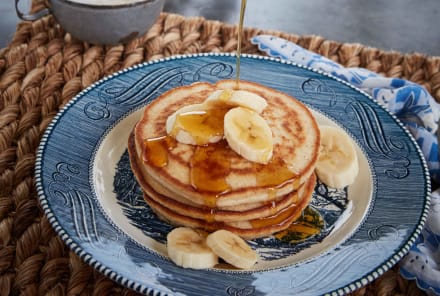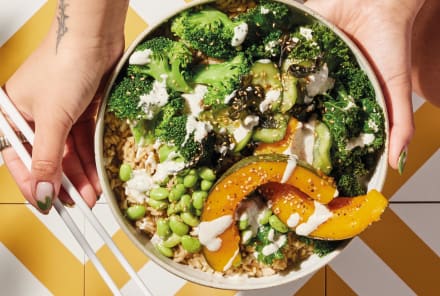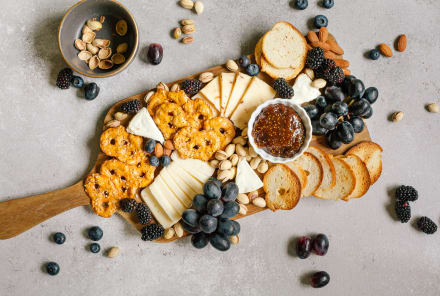Advertisement
This Blood-Sugar-Balancing Diet May Finally Cure Your Carb Cravings


Feeling hangry, tired, and craving sweets? Your blood sugar is probably to blame. We all know the familiar sugar high and subsequent crash from noshing on too many cookies, but did you know even healthy foods like green juice, pineapples, and sweet potatoes can spike your blood sugar? And it may be affecting more than just your mood. Beyond stimulating sugar cravings, blood sugar imbalances can mess with your thyroid, throw your hormones out of whack, and lead to type 2 diabetes.
But, besides the obvious added sugars, how can you tell which food could spike your blood sugar and leave you feeling meh? Luckily, there is a handy rating system called the glycemic index that scores how different foods will affect your blood sugar. Here, we breakdown everything you need to know about the glycemic index, how your favorite foods rank, and what to eat for better blood sugar balance.
What is the glycemic index?
First of all, what exactly is the glycemic index? The glycemic index is a scoring system that classifies foods by their potential impact on blood glucose response. Essentially, how much and how quickly glucose (sugar) will be released into your bloodstream in response to digesting different carbohydrates. All carbohydrates are broken down into sugar during digestion, but how much sugar, and how your body responds to it, varies.
A food's glycemic index is calculated as the ratio of the blood glucose response to 50 grams of available carbohydrates (in any given food) compared to the blood glucose response to 50 grams of pure glucose. So, a food that quickly releases a lot of sugar and causes a large blood sugar spike would score higher on the glycemic index than one that causes a more modest and steady blood sugar rise.
The following is a breakdown of how foods are scored on the glycemic index:
- 55 or lower: These foods have a low glycemic index.
- 56-69: These foods have a medium glycemic index.
- 70 or higher: These foods have a high glycemic index.
The basics: How high and low glycemic foods affect the body.
The glycemic index was initially developed in the 1980s to help guide food choices for patients with diabetes. It is critical for individuals with diabetes to maintain stable blood glucose levels for optimal health. However, the glycemic index has recently gained popularity in the general public as a way to control cravings, boost energy, and lose weight. In fact, many popular diet plans, like Zone and South Beach, are based on the principles of balancing blood sugar levels. By promoting low glycemic index foods, these types of diets aim to avoid sharp increases in blood sugar and the subsequent sugar crash.
Why that's important? When blood sugar levels rapidly rise and fall due to high glycemic foods, they can actually dip below initial levels, stimulating hunger. Low glycemic foods, on the other hand, offer a slow and steady rise in blood sugar, allowing the body to return to normal levels without stimulating hunger. Additionally, low glycemic foods tend to have higher fiber, increasing satiety. For these reasons, diets rich in low glycemic index foods have been associated with increased weight loss1. In fact, studies have shown that following a low glycemic index diet plan is as effective as a conventional low-fat diet2.
Beyond weight loss, maintaining stable blood sugar levels through a diet rich in low glycemic index foods has many health benefits. Small fluctuations in blood sugar levels in response to eating is normal. But a dramatic fluctuation in blood sugar, from high glycemic index foods, may have negative short- and long-term effects.
Immediately after eating high glycemic foods, the body ramps up the production of insulin to shuttle glucose into cells and stabilize blood sugar levels. You may feel a rush of energy followed by irritability, shakiness, and hunger as your blood sugar drops back down. Over time, these fluctuations in blood sugar and insulin levels can lead to insulin resistance3, a precursor of type 2 diabetes. Studies have found that following a low glycemic index diet can decrease the risk of insulin resistance and the development of diabetes. In fact, a large meta-analysis found that people who ate a low glycemic index diet had a 33 percent lower risk of developing diabetes4 than those who consumed a high glycemic index diet.
Consistently elevated blood sugar and insulin levels have also been found to promote inflammation, weight gain, and heart disease. "High blood sugar is toxic and can lead to serious health issues, and the blood sugar your body doesn't burn is stored as fat around your liver, stomach, and in circulating fat (known as triglycerides)," Will Cole, D.C., IFMCP, functional nutrition expert, told mbg.
That said, high glycemic index foods aren't all bad. These foods, due to the rapid release of sugar, are great if you need a quick surge of energy (think: during a long training session or to recover after a tough boot camp class). That's why you might find yourself reaching for a fructose-rich banana after a long run.
What about glycemic load and net carbs?
There are some limitations to be aware of when it comes to actually applying the glycemic index to your diet. For example, it does not take into account ripeness, cooking method, or processing when classifying a food's glycemic index. The true glycemic index of a food can vary greatly when these factors are considered—for instance, a banana can progress from a low glycemic index food to high glycemic index food over the course of ripening.
Additionally, these classifications are made in isolation. Meaning, when researchers calculate a carbohydrate's glycemic index, they do not consider it in the context of a meal. Why that's flawed: Protein and fat slow the absorption of carbohydrates, which in turn blunts the blood sugar response—so a high glycemic index food may actually act like a low glycemic index food when eaten with protein or fat. (That's why R.D.s always recommend pairing fruit with nut butter!)
One way to try to account for this is "net carbs." To calculate the net carbs in a food item, you subtract the fiber and sugar alcohols from total carbohydrates. Fiber slows the absorption of carbohydrates, limiting blood sugar spikes, while sugar alcohols may have little effect on blood sugar. This can be used as a tool to quickly calculate how a food may affect your blood sugar; however, the American Diabetes Association warns this method is not always accurate.
Another important consideration: serving size. Remember, the glycemic index is calculated as the effect of 50 grams of available carbohydrates in the tested food. However, this may far exceed a typical serving size. For example, a watermelon is considered a high glycemic index food with a score of 76, but you would have to consume an entire watermelon to eat 50 grams of available carbohydrates and stimulate that level of glucose response. To account for this discrepancy, another system, called the glycemic load, was developed. The glycemic load is calculated as the number of carbohydrates in one serving multiplied by the glycemic index, then divided by 100. Rather than a numerical value, glycemic load is a percentage. Taking this into consideration, a watermelon would have the much lower glycemic load of 5 percent.
The following is a breakdown of how foods are scored based on glycemic load:
- 1-10: These foods have a low glycemic load.
- 11-19: These foods have a medium glycemic load.
- 20 or higher: These foods have a high glycemic load.
How to eat using the glycemic index.
So, how can you use the glycemic index and glycemic load in your diet plan? If you are looking to maintain stable blood sugar levels and drop pounds, focusing on low glycemic index foods that offer a slow and steady release of energy rather than a sudden spike may help you achieve your goals—as long as you take into consideration the caveats mentioned above.
The glycemic index can also be incorporated into other diet plans, even ones that limit carbohydrates (lookin' at you, keto). These types of diets tend to encourage low glycemic index foods like berries (considered some of the healthiest fruits in the world) and leafy greens to maximize "good" carbs without sacrificing ketosis.
Where do common carb-containing foods rank on the glycemic index?
You're probably wondering how your favorite carbohydrate-containing foods score when it comes to the glycemic index. But remember, serving size, meal components, and cooking method may change how your body processes these carbs. Aim to eat foods that are low or medium, or combine high glycemic foods with proteins or fats to lower their overall effect on your blood sugar.
Low GI Foods (55 or less)
- Nonstarchy vegetables (leafy greens, broccoli, cauliflower, bell peppers, asparagus, etc.)
- Legumes (peas, lentils, beans, etc.)
- Carrots
- Quinoa
- Barley
- Rolled or steel-cut oats
- Berries
- Apples
- Pears
- Citrus fruits
- Milk
- Yogurt
Medium GI Foods (56-69)
- Whole wheat bread
- Brown rice
- Quick oats
- Sweet potato
- Banana
High GI Foods (70 and higher)
- White potato
- White bread
- White rice
- Crackers
- Most breakfast cereals and instant oatmeal
- Pineapple
- Watermelon
Low glycemic index diet meal plan.
Curious what a low glycemic index diet might look like? Here are some easy-to-follow tips for balancing your blood sugar at every meal:
Breakfast: Ditch the bagel and get a steady stream of energy from a green smoothie. Just don't go overboard on sugar-rich fruits like mango. Stick to berries for some low glycemic index sweetness. Add chia seeds and/or almond butter to bump up the fiber and protein, blunting potential blood sugar spikes.
Lunch: Wraps and white bread can be full of refined carbohydrates, spiking your blood sugar. Ditch the sandwich for a salad with lentils and lean protein for more sustained energy. Or even use romaine lettuce as a bread substitute for your tuna salad.
Snack: For a quick crunch and hit of sweetness, try low glycemic index apples sprinkled with cinnamon (this spice has beneficial effects on blood sugar, too!)
Dinner: There's a reason cauliflower rice is so popular. With a glycemic index of just 15, this low-carb starch substitute is much kinder to your blood sugar than regular rice. Try it in a stir fry with other low glycemic index veggies like carrots, broccoli, and bell peppers.
The glycemic index can be a great tool for getting to know how different foods affect your body. However, keep in mind it is not a complete picture. It is simply a reflection of carbohydrates and does not tell you about the overall nutrients in a food. Just because white potatoes and whole wheat bread are classified as high glycemic index foods doesn't necessarily mean you should shun them altogether. Potatoes are a rich source of potassium, and whole grains are packed with fiber. Use the glycemic index for guidance, as part of a healthy lifestyle packed with whole foods and good-for-you nutrients.
Watch Next
Enjoy some of our favorite clips from classes
Enjoy some of our favorite clips from classes
What Is Meditation?
Mindfulness/Spirituality | Light Watkins
Box Breathing
Mindfulness/Spirituality | Gwen Dittmar
What Breathwork Can Address
Mindfulness/Spirituality | Gwen Dittmar
The 8 Limbs of Yoga - What is Asana?
Yoga | Caley Alyssa
Two Standing Postures to Open Up Tight Hips
Yoga | Caley Alyssa
How Plants Can Optimize Athletic Performance
Nutrition | Rich Roll
What to Eat Before a Workout
Nutrition | Rich Roll
How Ayurveda Helps Us Navigate Modern Life
Nutrition | Sahara Rose
Messages About Love & Relationships
Love & Relationships | Esther Perel
Love Languages
Love & Relationships | Esther Perel











